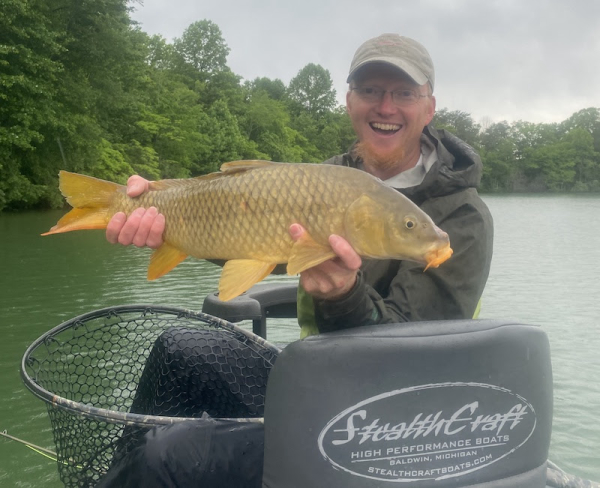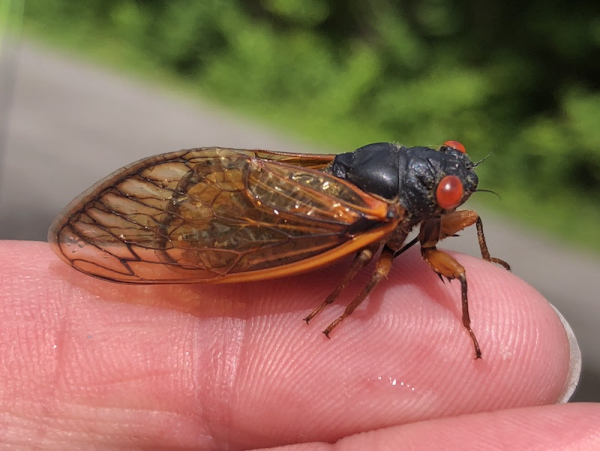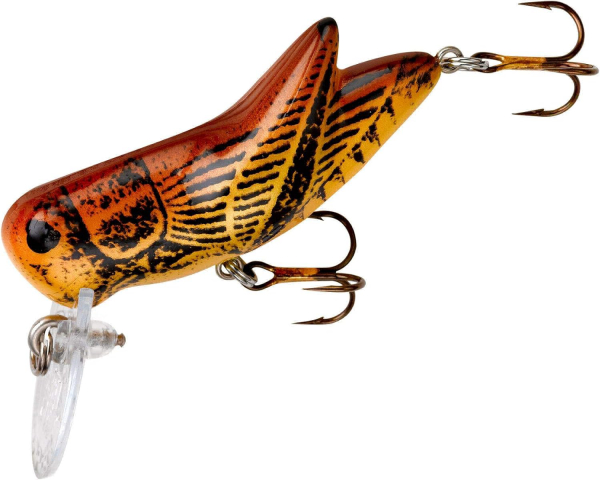
Carp are a major target during the cicada hatches, but bluegills, bass and also big trout readily feed on the bugs as they fall into the water. (Trout Zone Anglers)
Frank Sargeant
Frankmako1@gmail.com
If you live anywhere in cicada land, you are already well aware that they’re here.
The two cicada broods now hatching have not emerged together since 1803, and after this year, won't emerge together again until 2245. Right now across much of the eastern U.S., they are screaming their way to a peak.
The intense noise of nearby bugs, harmonized with the low steady roar of more distant ones, forms an outdoors cacophony that can’t be ignored.

Cicada's are beautiful at close range, but they produce noises that are almost painful to human ears. (Wikimedia)
Cicada’s have a remarkable life span, waiting 13 to 17 years under ground for their brief time to fly and sing and reproduce themselves.
They are beautiful creatures newly shed, in shades of glowing iridescent orange with bright red eyes. But they make a noise that’s almost painful to the human ear at close range.
To say there are a lot of them doesn’t begin to capture the numbers—entomologists say up to 1.5 million per acre in some areas! Think of it. We may actually have more cicadas hatching this year than there are dollars added to the national debt!
Per the Nature Conservancy, they are in at least 15 states, and I can vouch that they are in 16 because they omitted Alabama and we are covered up with them near Guntersville.
A lot of these newly hatched bugs fall into rivers and lakes, and Nature never overlooks a food source.

The Rebel Crickhopper is among the lures that work well in many waters when the cicada hatch is on. (Rebel Lures)
Bluegills, bass, catfish and carp all eat them. So do large trout, per David Knapp, head of Trout Zone Anglers in Crossville, Tennessee. David and his team of guides primarily fish the Clinch River and Caney Fork tailwaters in drift boats, and they are very good at it, with experienced fly fishers landing rainbows and browns in the 20” inch range with some frequency.
But Knapp says his favorite fishing during cicada years is actually the carp because they are so abundant and so big, on average, and also so powerful—a 5 or 10 pound carp in a fast-flowing river is a formidable fish on a fly rod, to be sure. Not many of us will ever catch a 5-pound rainbow or brown, but you’re likely to catch several carp that size in a morning when the bug hatch is on.
You can catch fish around cicadas falling into the water on any sort of fly rod popper or floating bucktail bug. But you don’t have to be a fly rodder to get them. With an ultralight spinning rig and some of PRADCO’s little floating bug lures like the Rebel Crickhopper, you can load up on bluegills along the shorelines of many lakes right now. (Just like finding bluegills on beds, though, you have to motor the forested shorelines until you find good numbers of the bugs falling into the water.)
Where you find bluegills, you’ll sometimes find bass, catfish and carp as well. Particularly when a strong wind is pushing the insects off the trees into the water, the bite is likely to be on.
Trout Zone Anglers is headquartered in Crossville, Tennessee: TroutZoneAnglers@gmail.com (931) 261-1884.
You wouldn’t expect it given the very rare timing of the bug pulses, but one very good writer has written a book on how to catch fish in cicada years: Dave Zielinski’s book is titled Cicada Madness: Timing, Fishing Techniques, and Patterns for Cracking the Code of Epic Cicada Emergences (Stackpole Books, 2023)